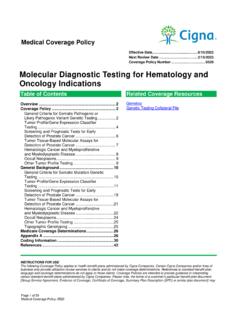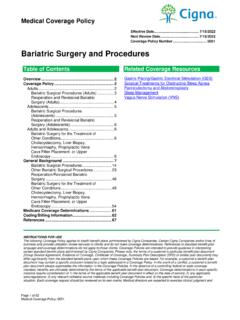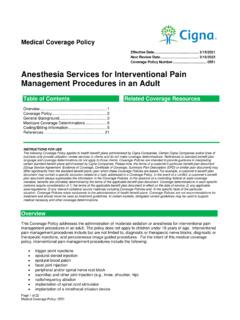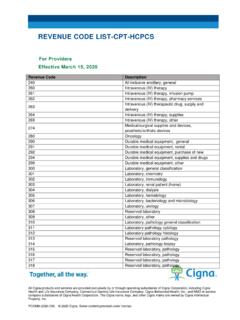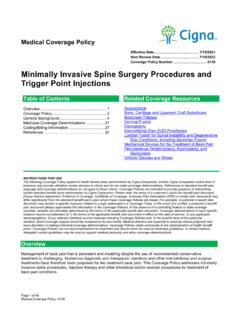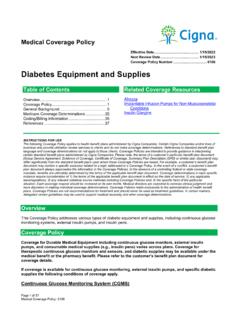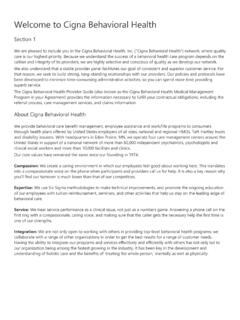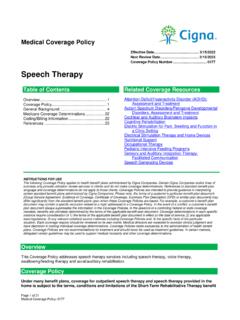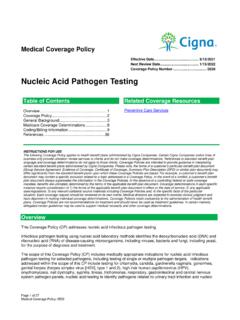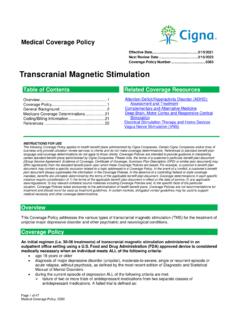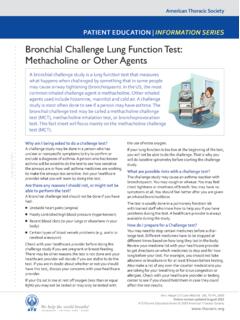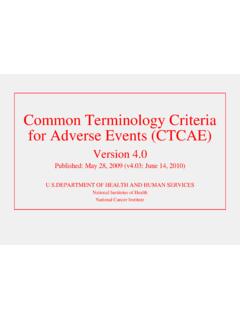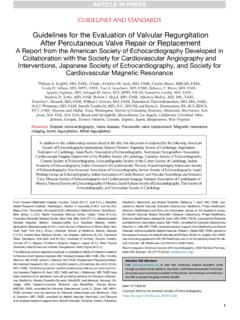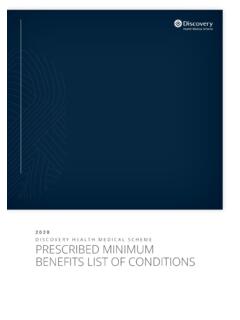Transcription of Transthoracic Echocardiography in Adults - Cigna
1 Medical Coverage Policy Effective Date ..11/15/2021. Next Review Coverage Policy Number .. 0510. Transthoracic Echocardiography in Adults Table of Contents Related Coverage Resources Overview ..1 eviCore Adult Cardiac Imaging Guideline Coverage Policy ..1 Nonpharmacological Treatments for Atrial Fibrillation Nonvalvular heart disease ..1 Transthoracic Echocardiography in Children Valvular heart disease ..6. Congenital heart disease .. 15. Frequency of TTE .. 15. Myocardial strain imaging .. 15. General Background .. 16. Medicare Coverage Determinations .. 39. Coding/Billing 39. References .. 53. INSTRUCTIONS FOR USE. The following Coverage Policy applies to health benefit plans administered by Cigna Companies. Certain Cigna Companies and/or lines of business only provide utilization review services to clients and do not make coverage determinations. References to standard benefit plan language and coverage determinations do not apply to those clients.
2 Coverage Policies are intended to provide guidance in interpreting certain standard benefit plans administered by Cigna Companies. Please note, the terms of a customer's particular benefit plan document [Group Service Agreement, Evidence of Coverage, Certificate of Coverage, Summary Plan Description (SPD) or similar plan document] may differ significantly from the standard benefit plans upon which these Coverage Policies are based. For example, a customer's benefit plan document may contain a specific exclusion related to a topic addressed in a Coverage Policy. In the event of a conflict, a customer's benefit plan document always supersedes the information in the Coverage Policies. In the absence of a controlling federal or state coverage mandate, benefits are ultimately determined by the terms of the applicable benefit plan document. Coverage determinations in each specific instance require consideration of 1) the terms of the applicable benefit plan document in effect on the date of service; 2) any applicable laws/regulations; 3) any relevant collateral source materials including Coverage Policies and; 4) the specific facts of the particular situation.
3 Coverage Policies relate exclusively to the administration of health benefit plans. Coverage Policies are not recommendations for treatment and should never be used as treatment guidelines. In certain markets, delegated vendor guidelines may be used to support medical necessity and other coverage determinations. Overview This Coverage Policy addresses non-stress Transthoracic Echocardiography (TTE) in an adult age 18 or older. Coverage Policy Nonvalvular heart disease INITIAL EVALUATION OF AN ASYMPTOMATIC PATIENT. in Nonvalvular Heart Disease Transthoracic Echocardiography (TTE) (With or without three-dimensional [3D]; with contrast as needed) is Considered Medically Necessary: Page 1 of 55. Medical Coverage Policy: 0510. Initial cardiac evaluation of a known systemic, congenital, or acquired disease that could be associated with structural heart disease Screening evaluation for structure and function in first-degree relatives of a patient with an inherited cardiomyopathy Initial evaluation prior to exposure to medications/radiation that could result in cardiotoxicity/heart failure Pre-operative evaluation of cardiac structure and function prior to non-cardiac solid organ transplantation Evaluation of the ascending aorta in the setting of a known or suspected connective tissue disease or genetic condition that predisposes to aortic aneurysm or dissection ( , Marfan syndrome).
4 Screening evaluation in relatives of a patient with known aortic aneurysm or dissection Preparticipation assessment of an asymptomatic athlete with 1 of the following: abnormal examination, abnormal electrocardiogram (ECG), or definite (or high suspicion for) family history of inheritable heart disease Evaluation of suspected pulmonary arterial hypertension, including evaluation of right ventricular function and estimated pulmonary artery pressure in a patient at risk for developing pulmonary arterial hypertension Individual with Dravet syndrome TTE (With or without 3D; with contrast as needed) is Considered NOT Medically Necessary: Preparticipation athlete assessment in a patient with no symptoms, normal examination, and no family history of inheritable heart disease As a screening study prior to starting Attention-deficit/Hyperactivity disorder (ADHD) drugs Infrequent atrial premature contractions (APCs), infrequent ventricular premature contractions (VPCs).
5 Without other evidence of heart disease, or asymptomatic isolated sinus bradycardia INITIAL EVALUATION OF A PATIENT WITH CLINICAL SIGNS AND/OR SYMPTOMS. in Nonvalvular Heart Disease TTE (With or without 3D; with contrast as needed) is Considered Medically Necessary: Initial evaluation when symptoms or signs suggest heart disease Arrhythmias or Conduction Disorders Newly diagnosed left bundle branch block (LBBB). Newly diagnosed right bundle branch block (RBBB). Frequent ventricular premature contractions (VPCs) without other evidence of heart disease Nonsustained ventricular tachycardia (VT). Sustained VT or ventricular fibrillation (VF). Evaluation of the patient with episodes of supraventricular tachycardia (SVT) without other evidence of heart disease Atrial fibrillation/flutter (not for purposes of Precardioversion evaluation). Palpitations/Presyncope/Syncope Clinical symptoms or signs consistent with a cardiac diagnosis known to cause presyncope/syncope (including but not limited to hypertrophic cardiomyopathy and heart failure [HF]).
6 Palpitations without other symptoms or signs of cardiovascular disease Presyncope without other symptoms or signs of cardiovascular disease Syncope without other symptoms or signs of cardiovascular disease Hypotension or Hemodynamic Instability Hypotension or hemodynamic instability of uncertain or suspected cardiac etiology Assessment of volume status in a critically ill patient Hypertensive Heart Disease Initial evaluation of suspected hypertensive heart disease Acute Coronary Syndrome (ACS). Evaluation of left ventricular (LV) function during initial presentation with acute coronary syndrome Page 2 of 55. Medical Coverage Policy: 0510. Suspected complication of myocardial ischemia/ infarction, including but not limited to acute mitral regurgitation, ventricular septal defect, free-wall rupture/tamponade, shock, right ventricular involvement, HF, or intraventricular thrombus Respiratory Failure/Exertional Shortness of Breath Exertional shortness of breath/dyspnea or hypoxemia of uncertain etiology Heart Failure/Cardiomyopathy Initial evaluation of known or suspected HF (systolic or diastolic) based on symptoms, signs, or abnormal test results to assess systolic or diastolic function and to assess for possible etiology (coronary artery disease [CAD], valvular disease).
7 Suspected inherited or acquired cardiomyopathy ( , restrictive, infiltrative, dilated, hypertrophic). Evaluation of LV function in patients who are scheduled for or who have received chemotherapy Pulmonary Hypertension Evaluation of suspected pulmonary hypertension including evaluation of right ventricular function and estimated pulmonary artery pressure Device Therapy Evaluation after appropriate time interval following revascularization and/or optimal medical therapy to determine candidacy for implantable cardioverter-defibrillator (ICD)/ cardiac resynchronization therapy (CRT) and/or to determine optimal choice of device Initial evaluation for CRT device optimization after implantation Known implanted pacing/ ICD/CRT device with symptoms possibly due to suboptimal device settings To determine candidacy for ventricular assist device Optimization of ventricular assist device settings Cardiac Transplantation Monitoring for rejection or coronary arteriopathy in a cardiac transplant recipient Cardiac structure and function evaluation in a potential heart donor Other Suspected pericardial diseases Initial evaluation of cardiac mass, suspected tumor or thrombus, or potential cardiac source of emboli Suspected acute aortic pathology including acute aortic syndrome Multisystem Inflammatory Syndrome (MIS) associated with SARS-CoV-2 (COVID-19) infection TTE (With or without 3D.)
8 With contrast as needed) is Considered NOT Medically Necessary: Hypertensive Heart Disease Routine evaluation of systemic hypertension without symptoms or signs of hypertensive heart disease Respiratory Failure/Exertional Shortness of Breath Exertional shortness of breath /dyspnea or hypoxemia when a noncardiac etiology of dyspnea has been established SEQUENTIAL OR FOLLOW-UP TESTING TO CLARIFY INITIAL DIAGNOSTIC TESTING. in Nonvalvular Heart Disease TTE (With or without 3D; with contrast as needed) is Considered NOT Medically Necessary: Further anatomic characterization of anomalous coronary arteries identified by invasive coronary angiography SEQUENTIAL OR FOLLOW-UP TESTING: ASYMPTOMATIC OR STABLE SYMPTOMS. in Nonvalvular Heart Disease TTE (With or without 3D; with contrast as needed) is Considered Medically Necessary: Re-evaluation (<1 y) in a patient previously or currently undergoing therapy with potentially cardiotoxic agents Re-evaluation ( 1 y) of known moderate or greater pulmonary hypertension without change in clinical status or cardiac examination Page 3 of 55.
9 Medical Coverage Policy: 0510. Re-evaluation of chronic asymptomatic pericardial effusion when findings would potentially alter therapy Re-evaluation of intracardiac mass when findings would potentially alter therapy TTE (With or without 3D; with contrast as needed) is Considered NOT Medically Necessary: Re-evaluation (<1 y) in a patient at risk for heart failure (HF) without structural heart disease on prior TTE and no change in clinical status or cardiac examination (stage A). Re-evaluation of known hypertensive heart disease without a change in clinical status or cardiac examination (stage A) (<1 y). Re-evaluation (<1 y) of HF (systolic or diastolic) cardiomyopathy or HF without a change in clinical status or cardiac examination Re-evaluation (<1 y) of known aortic dilatation at baseline study to assess changes in rate of expansion or size in patient without bicuspid aortic valve Re-evaluation (<1 y) of the size and morphology of the aortic sinuses and ascending aorta in patients with a bicuspid aortic valve and an aortic diameter >4 cm without characteristics mentioned in the indication below Re-evaluation (<1 y) of the size and morphology of the aortic sinuses and ascending aorta in patients with a bicuspid aortic valve and an aortic diameter >4 cm with one of the following: aortic dilatation > cm; Rapid rate of change in aortic diameter.
10 Family history of aortic dissection Re-evaluation (<1 y) of known moderate or greater pulmonary hypertension without change in clinical status or cardiac examination Further clarification of suspected pericardial constriction when findings of TTE including tissue Doppler is unclear Re-evaluation of prior TEE findings for interval change ( , resolution of atrial thrombus after anticoagulation) when no change in therapy is anticipated. SEQUENTIAL OR FOLLOW-UP TESTING: NEW OR WORSENING SYMPTOMS OR TO GUIDE THERAPY. in Nonvalvular Heart Disease TTE (With or without 3D; with contrast as needed) is Considered Medically Necessary: Re-evaluation of known structural heart disease with change in clinical status or cardiac examination or to guide therapy (assume ischemic work-up has been performed and remains valid). Re-evaluation of prior TEE findings for interval change ( , reduction or resolution of atrial thrombus after anticoagulation or intracardiac evaluation of cardiac mass when a change in therapy is anticipated Re-evaluation of known cardiomyopathy with a change in clinical status or cardiac examination or to guide therapy (assume ischemic work-up has been done, performed, and remains valid).)
